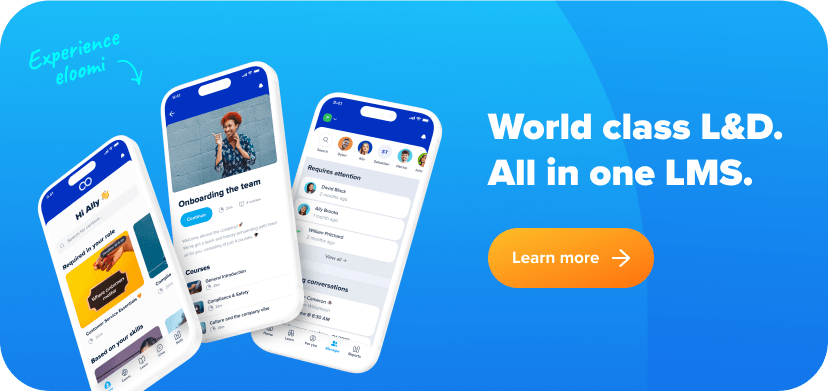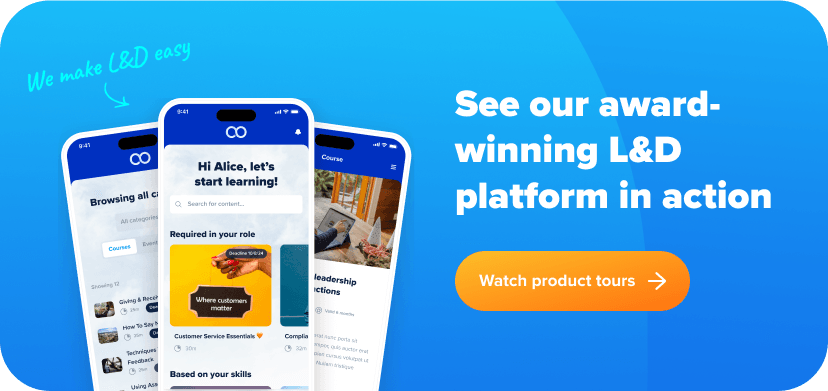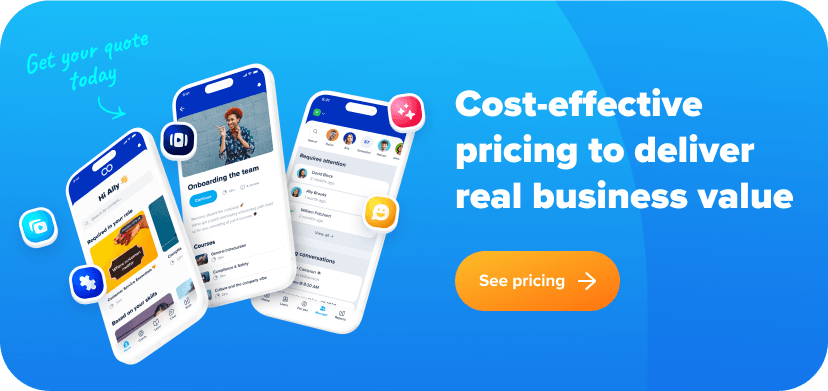Employee training has rapidly evolved since the rise of hybrid and remote work. Many HR and L&D teams now leverage LMS platforms for digital training, which has shown that online learning has a host of benefits: including increased employee engagement, training efficiency, and productivity.
Digital training platforms also make new training methods possible, prompting debate around the benefits of hybrid learning vs blended learning approaches.
In this article, we’ll dig into hybrid learning vs blended learning, explore the differences between these two learning approaches, and help you understand how to choose the best approach to employee training for your organization.
What is hybrid learning?
Hybrid learning is an approach to training that combines in-person classroom training and online training. Learners can attend physically as well as virtually, and the instructor presents to both groups simultaneously. This allows for greater flexibility through the use of technology and supports a synchronous learning approach.
Organizations increasingly use hybrid learning setups to accommodate remote or hybrid employees, conducting training via video conferencing and virtual workshops. Hybrid learning is beneficial as it can easily scale to support global training, reduces training costs, and helps employees build a sense of community, no matter their location.

Hybrid learning benefits and challenges
There are many benefits to a hybrid learning approach, especially for organizations with both in-office and remote employees as it supports both groups and allows for synchronous training. The key reasons why organizations choose hybrid learning models include:
- Flexibility: Employees working remotely or in hybrid setups can participate in training sessions conveniently from any location.
- Cost-savings: Organizations can save on expenses related to in-person training, such as equipment, travel, and venue costs.
- Time-efficiency: Instructors don’t need to schedule multiple sessions to ensure everyone can attend training, as employees can join online.
- Scalability: Training sessions can support a larger number of participants than in a physical classroom setup, allowing more employees to participate simultaneously.
- Increased engagement: Hybrid learning typically offers higher engagement through interactive elements that appeal to diverse learning styles.
However, there are also disadvantages and challenges that come with a hybrid learning model:
- Split attention: Instructors may find it challenging to engage with both in-person and online learners, requiring them to balance their focus across both groups.
- Dependence on technology: Reliable internet and tech infrastructure are essential for a smooth hybrid learning experience; weak connectivity can disrupt learning.
- Increased planning: Instructors need to be prepared to coordinate activities across both physical and virtual settings.
What is blended learning?
Blended learning is a training approach that combines in-person workshops with online training resources. All learners attend classroom training led by an instructor, but they also have access to digital materials such as courses, reading material, pre-recorded lectures, and quizzes that they can access online.
Blended learning is an asynchronous approach to training, as learners can access material online at their own pace before attending in-person sessions. This emphasis on self-paced learning can help in corporate training environments, where employees are able to access training as needed, but still attend structured training sessions where instructors can support learning and test their knowledge.
Blended learning benefits and challenges
Blended learning has numerous benefits for organizations as it incorporates the best of in-classroom training as well as digital resources. Some of the main benefits of blended learning include:
- Accessibility: Self-led learning enables employees to access training at a pace and time that suits them, making learning more flexible to individual schedules.
- Inclusivity: Digital resources allow for the accommodation of different learning styles, with access to reading material, video, and knowledge checks.
- Increased interactivity: Online materials often include interactive elements, like videos and quizzes, that help reinforce learning and maintain engagement.
- In-person feedback: Face-to-face sessions allow instructors to monitor learner progress and provide direct feedback, facilitating more effective knowledge retention.
- Efficiency: Instructors can focus on in-person sessions, as learners prepare independently by completing online modules as needed.
However, there are also disadvantages and challenges that come with a blended learning model:
- Course design: Blended learning requires the development of high-quality, standalone digital resources that learners can rely on independently.
- Learner accountability: Since learners progress through the material on their own, they are responsible for staying up-to-date, which may require instructors to send reminders or follow up with those who fall behind.
- Ensuring uniformity: When learners engage with content on their own, in-person sessions may reveal gaps in knowledge, as some learners may not have completed or fully absorbed the online content.

Hybrid learning vs. blended learning: 5 differences
1. Prioritizing in-classroom sessions
Hybrid learning accommodates both in-person and virtual learners at the same time. This allows everyone to participate in real-time, maintaining the structure of traditional in-classroom training with added flexibility for remote attendees.
Blended learning, however, prioritizes in-person sessions for all employees, providing time to review and reinforce content that learners have previously engaged with online. This learning approach is beneficial for organizations where employees can attend in-person sessions, but where access to digital resources can help save time and speed up training.
2. Enabling self-led learning
Blended learning offers greater flexibility for self-led learning, allowing employees to engage with online resources and materials at their own pace before attending live sessions. This setup also supports a more individualized learning experience, giving learners the freedom to review content when convenient.
In contrast, hybrid learning focuses less on self-led activities and more on synchronous participation, where both in-person and remote learners follow the instructor’s schedule. Hybrid learning can still incorporate some self-led activities, but it is more structured around real-time engagement.
3. Reliance on technology
Both hybrid and blended learning rely on digital setups to some degree. Hybrid learning relies on technology to enable simultaneous participation from in-person and remote learners, making it important to have video conferencing tools, a stable internet connection, and the ability to complete activities online.
Blended learning, on the other hand, incorporates online training materials. These could be files shared online, or training courses in an elearning platform or LMS. Since most learning is asynchronous, blended learning does not require a complex tech setup, making it a simpler solution for organizations without extensive resources.
4. Instructor workload
Hybrid learning places higher demands on instructors, who must manage the needs of both in-person and online participants simultaneously. This can require skills in multitasking and familiarity with various tools to ensure both groups are active and engaged.
Instructors in a blended learning setup, however, primarily focus on facilitating in-person sessions and designing engaging, self-led online materials. This setup requires less real-time management but demands thoughtful planning to create effective, standalone online resources.
5. Cost of implementation
The costs of implementing hybrid and blended learning models vary depending on your organizational size and goals. Hybrid learning relies on the organization having a hybrid work approach, with all employees able to access remote work equipment, such as high-quality cameras, microphones, and screens.
Blended learning typically involves less upfront spending on equipment, but does depend on high-quality, interactive digital content and resources that support effective self-led learning. While both models require investment, the cost structure for hybrid learning is more equipment-focused, whereas blended learning is centered on content creation.
| Hybrid learning | Blended learning |
| Remote and hybrid | In-person |
| Synchronous | Asynchronous |
| Primarily instructor-led | Primarily self-led |
| Requires technical setup | Requires digital content creation |
| Scalable | Classroom dependent |

How to choose between hybrid and blended learning
Choosing between hybrid and blended learning depends on your organization’s training requirements, available resources, budget, and instructional support.
If your organization is dispersed globally or has a mix of remote and in-person employees who, hybrid learning is ideal to facilitate training regardless of location. This model works well for events like international conferences or team meetings, where real-time interaction fosters engagement and collaboration across different locations.
Blended learning, on the other hand, is well-suited for professional development courses or ongoing training where employees can progress through materials independently, at a pace that fits their schedules. This model is especially valuable when in-person sessions can serve to clarify and deepen understanding of content first covered online. However, blended learning does require that your employees are able to meet up on site for in-person sessions.
By evaluating these aspects, you can select the model that best aligns with your training goals and resource availability. eloomi’s LMS supports both hybrid and blended learning approaches, so you can deliver accessible learning and development for in-person and online training.
LMS platforms for hybrid and blended learning
Hybrid and blended learning are valuable approaches for employee training, each with unique benefits and challenges suited to different organizational needs. The choice between hybrid and blended learning ultimately depends on factors like organizational structure, available resources, and the type of content to be delivered.
LMS platforms like eloomi can support both hybrid and blended learning approaches, with scheduling for in-classroom training as well as elearning content creation tools and course management, providing the flexibility and functionality needed to support hybrid organizations. With a digital approach to employee training, you can leverage the strengths of either model to enhance employee engagement, learning efficiency, and overall productivity.
If you’d like to learn more about how an LMS can support you with hybrid or blended learning, get in touch for a personalized product demo.






